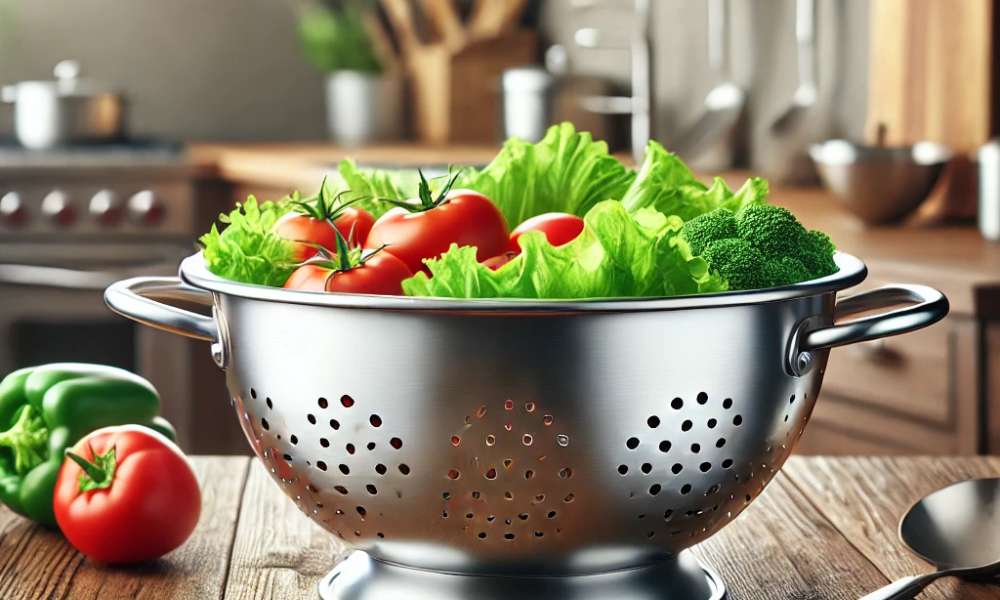A colander is a staple in kitchens worldwide, yet its versatility often goes unnoticed. So, what is a colander used for in cooking? This perforated tool is essential for tasks like draining pasta, rinsing vegetables, and washing grains. But its functionality doesn’t stop there. From separating liquids to serving as an impromptu steamer, the colander proves its worth time and again. Whether you’re a seasoned chef or a casual cook, understanding how to use a colander effectively can make meal preparation smoother and more efficient.
The Essential Role of Colanders in the Kitchen
At its core, the colander is a tool of convenience. It’s indispensable for draining water from boiled ingredients, ensuring your dishes are free of excess liquid. Whether it’s separating the starch from pasta water or washing grains like quinoa, the colander provides a quick and effective solution. Additionally, its perforations ensure that even the smallest particles are held securely, making it ideal for both large and delicate ingredients.
Different Types of Colanders and Their Uses
Colanders come in various shapes, sizes, and materials, each designed for specific culinary tasks. Traditional metal colanders are robust and heat-resistant, perfect for draining boiling liquids. Plastic colanders, lightweight and affordable, are excellent for rinsing fruits and vegetables. Meanwhile, mesh colanders provide precision, especially for finer ingredients like rice or lentils. There are even collapsible silicone colanders, which save space without compromising functionality. Understanding the variety available helps you select the right tool for your kitchen needs.
How to Choose the Right Colander for Your Needs
Selecting the perfect colander depends on your cooking habits and the types of dishes you frequently prepare. For those who cook pasta regularly, a sturdy stainless steel colander with larger holes is ideal. On the other hand, if you often handle delicate produce, a fine-mesh colander ensures thorough cleaning without bruising. Consider the size of the colander in relation to your kitchen storage space, and opt for ergonomic handles or a base for added stability.
Common Cooking Tasks That Require a Colander
Colanders play a pivotal role in several everyday kitchen tasks. Draining cooked pasta, rinsing salad greens, washing berries, and straining boiled vegetables are just the tip of the iceberg. They’re also essential for tasks like draining canned beans or seafood and even separating curds from whey during cheese-making. The versatility of a colander ensures it’s a go-to tool for home cooks and professional chefs alike.
Creative Uses for a Colander Beyond Cooking
While colanders are primarily cooking tools, their utility extends beyond the kitchen. They can double as a fruit basket, allowing air to circulate and keep produce fresh. In a pinch, they serve as a steamer when placed over boiling water. Craft enthusiasts might repurpose them as planters or light fixtures, transforming a humble kitchen item into a piece of decor. The possibilities are as creative as your imagination.
Materials Used in Colander Design: Pros and Cons
Colanders are crafted from a range of materials, each with its own advantages and drawbacks. Stainless steel colanders are durable and resistant to heat, making them perfect for high-temperature tasks. Plastic colanders, though affordable and lightweight, may lack the durability of metal options. Silicone colanders offer flexibility and easy storage but may not withstand heavy-duty use. Choosing the right material ensures longevity and optimal performance.
Tips for Properly Using a Colander in Cooking
To make the most of your colander, always ensure it’s placed securely in the sink or on a stable surface. For rinsing grains, consider using a fine-mesh colander to avoid losing small particles. When draining hot liquids, pour slowly to prevent splashing. For multi-step recipes, having multiple colanders can streamline your process and save time.
Cleaning and Maintaining Your Colander
Proper care extends the life of your colander. Rinse it immediately after use to prevent food residue from drying and clogging the holes. For metal colanders, avoid abrasive scrubbers that can scratch the surface. Plastic strainers should be cleaned with gentle soap to prevent discoloration. Always ensure your colander is thoroughly dry before storing to avoid rust or mildew.
Colanders vs. Strainers: Understanding the Difference
Though colanders and strainers share similarities, they serve distinct purposes. Colanders typically have larger holes and are used for draining larger food items, such as pasta or vegetables. Strainers, with their fine mesh, are better suited for sifting flour, straining sauces, or separating liquids from small solids. Knowing the difference ensures you use the right tool for the job.
Best Recipes That Involve Using a Colander
Colanders shine in recipes that require precise draining or rinsing. Think creamy fettuccine alfredo, vibrant Greek salads, or hearty potato soups. They’re also essential for preparing dishes like steamed broccoli, washed quinoa, or even homemade ricotta cheese. By mastering the art of using astrainer, you can elevate your culinary creations effortlessly.
Eco-Friendly and Innovative Colander Options
As sustainability becomes a priority, many brands now offer eco-friendly colanders made from biodegradable materials or recycled plastics. Innovations like collapsible designs or strainers with built-in bowls for water collection minimize waste and maximize convenience. Investing in these options supports both functionality and environmental consciousness.
Conclusion
The humble colander is far more than a kitchen accessory; it’s a versatile and indispensable tool that simplifies a multitude of cooking tasks. From draining to steaming, its utility is unmatched. By understanding its various types, uses, and maintenance, you can unlock its full potential. Every kitchen deserves a strainer, a tool that truly stands the test of time and innovation.
